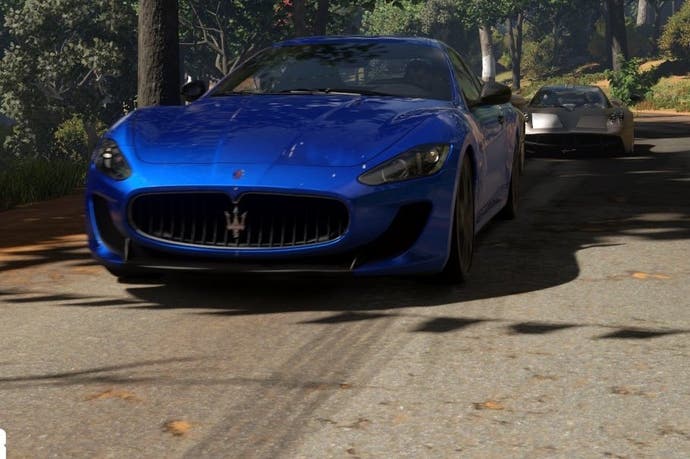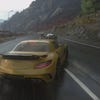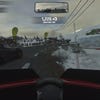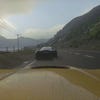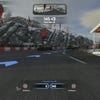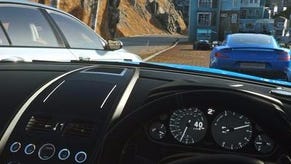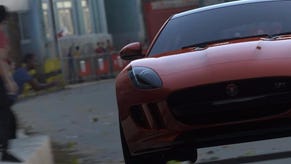Digital Foundry: Hands-on with DriveClub
Impressions, analysis and discussion with Evolution Studios.
In our first technical preview of DriveClub last year we had Evolution Studios' racer down as a promising, if rough-edged effort - a pre-alpha build that clearly needed work. And sure enough, its appearance at Sony's 2014 Gamescom conference has shown a project revitalised in all the right areas. The frame-rate is smoother, the landscape detail massively upgraded, while a slew of new effects and lighting tricks are added. It looks like a whole new game.
The studio's art director Alex Perkins says there was a lot for the team to reflect on after its 2013 E3 showing.
"We came with a very honest build," he recalls. "It was good to get 3500 people playing it over three days - you don't get that amount of detailed feedback that quickly anywhere else other than E3. We gave you exactly what was running on PS4, [and] we knew what we needed to improve."
The switch from the original 60fps target to a locked 30fps has proven controversial, particularly given DriveClub's place as the PS4's first major racing game. Asked if he's happy with the capped refresh, Perkins is convinced: "Yes, as an artist I'm always happy for pretty."
It's a classic trade-off; one in favour of visual integrity over performance, putting the PS4's horsepower to use in different ways. Systems for depth-of-field, the lighting model and reflections have all been upgraded, alongside the eventual arrival of a weather system (coming after launch). But a drive through an overcast Scotland track in a Mercedes SLS screams aloud the team's proudest achievement.
"It's the whole dynamic nature of the game. Nothing's baked, nothing's faked. We run everything real-time, and some of the demonstrations I've done you can speed the time-of-day to up to 500 times and see all the clouds roll by," Perkins continues. "We've got a fully volumetric cloud system. You play the same track 20 times in a row and you'll get a different sunset every time. It all feeds back, and because of the atmospherics and the draw distances it's all mixed in - from the cars to the roads to the mountains to the skies."
The ability to simulate full atmospheric conditions, such as time of day, cloud and wind, is a major addition, and one that's due to develop further with a weather update, adding effects like rain and snow. But was weather the main reason for the game's eight-month delay?
"It was always at the back of my mind to keep the game's systems as dynamic as possible. You can't do Scotland without rain, and you can't do Norway without snow. The building blocks were already in there; it was a case of the extra time gave us a chance to finesse the game as it stood and then build in all the extra elements, [such as] the weather systems.
"One thing you can see, everything's reflected in the road surface. We're not doing this just locally to the track surface. You can fly out as far as you like. It goes all the way to the top of the mountain, so if the sun pokes through you'll get massive highlights where the rock formations are. And of course all the materials interact differently. The grass gets wet differently to the rock, which is different to the tarmac, which is different to the plastics."
To achieve DriveClub's consistency in lighting, reflections and effects across the world, a materials-based system is in place across all cars and tracks. Every surface is built to reflect light according to real-life values; a time-consuming process that - according to the team - means each car takes up to seven months to produce.
"We developed our own system for actually capturing surface data. You find that around the cars and throughout the world as well," Perkins explains. "And then, of course, we've got highly detailed information on the manufacturers. Wherever we can we've used the data actually used to build the cars. So CAD data in particular, [it's as] as good as the engineers have."
Tying this all together is a string of rendering systems to make sure each element of the game links up. Asked if a deferred renderer is in place, Perkins is quick to reel off the list.
"It is. It's a mixture actually, we do lots of things," he says. "We've got a deferred rendering system, tile-based rendering system, a forward rendering system, all mixed together just to get all the variety you can [have] in certain situations and put them together."
It's a complex web that keeps the consistency of DriveClub's five locations intact, right down to the basics. Lighting in particular benefits, with every lamp or front beam on a car reflected across a track's slicked surface - where puddles dynamically rise around its recesses. Even mountains far into the distance are mirrored, with only the corners of a player's FOV cutting terrain details. The time of day, and clouds, have a major impact on shadow positioning too, causing our Pagani to cast long shadows against a low-cast Norwegian sun.
It's eye candy, but also brings with it an expected impact to each car's handling. To back this up, a procedural damage system is also in place, using multiple layers of materials across each car to simulate impact. The system recognises the point, speed and direction of another reckless driver, causing anything from a scuff to the paintwork, to a crumpled carbon fibre mesh across a vehicle's rear.
Weather conditions affect a driver's visibility at high speeds too. We get to see a blazing downhill drive in Norway with sleet bearing down heavily on the windscreen - the night road ahead barely perceptible beyond a few metres. Likewise for a torrential rainfall across Scotland's glens, the setting can make all the difference to the manner of race.
"We'll be adding things like screen-space effects to actually get all the water droplets on the screen. We'll get the wind-screen wipers working [too], that'll have a full simulation pass so that you get proper droplets," Perkins explains, using his own, private debug build to demonstrate. "It's all modelled. Because of the atmospherics system, everything has to be modelled. It all sits in and writes at the same level. It's one of those things that's really subtle and helps tie it all in."
The game's 1080p resolution is put to effective use too, producing one of the cleanest grades of image quality on PS4. And yet Evolution isn't content to leave it there, backing this full HD setup with an excess of techniques to tackle aliasing from every angle. Asked what anti-aliasing is fit for purpose in this case, DriveClub takes a no-compromise approach.
"It's a mixture. There's a pixel-based system that we're using, there's a temporal-based system, there's FXAA and there's actually a material-based system as well. We've only got four systems in place and we've got another for the key points that we don't quite hit. We obsess about the small details, so we're getting another one to go on top of that, to get on top of the very final image quality issues."
Asked if all these added passes for anti-aliasing add to the game's overall controller latency, Perkins quells the concern: "Everything needs to be immediate and direct for the player. We do everything as quickly as we can, because we want to get that across at 30 frames a second."
From a direct digital feed of Sony's live Gamescom demo, it's a convincing, constant 30fps for the Scotland and Norway stages. And thankfully there are no frame-pacing issues to speak of, nor tearing during the PS4-driven gameplay. Save for the introduction of tearing during a debug 'orbital' mode towards the demo's end, it's a perfectly locked experience during regular gameplay. But surely the game's internal systems work at above this 30Hz cap?
Talking briefly on its physics engine, Perkins explains how the game's handling model is designed to keep latency as low as possible. "The update rate for how it comes into place, tyre to surface, suspension to car, is much quicker than the actual refresh rate."
"The latency is as small as we could possibly make it. One of the things we [also] did when we were coming up with the PlayStation 4 itself was work heavily with the guys designing the controller, to make it much more responsive and much easier to use with driving games as well."
For our hands-on session, the game felt as tight as we could hope; a racer that joins the ranks of the industry's best running at this target frame-rate. The jump from the studio's arcade-style MotorStorm series to a more realistic racer has been a smooth one too - but did the developer need any outside help? With Polyphony Digital and its Gran Turismo series, some pointers from the Far East could have been insightful?
"No no, they work happily on their own, as do we," Perkins is quick to interject. "We collected all this data all ourselves. All the audio, all the vehicles. And as I say, it was a bespoke system we designed for doing all the material sampling. So it was pretty much all our own technology combined up in one big go."
Given that each car is laboriously designed down to the cockpit's LEDs and dials, the idea of Morpheus support for DriveClub is also very tempting. Virtual reality tech such as Oculus Rift is a lock-in for this year's Project Cars for example, allowing players to explore interior car detail not usually in view. But for Evolution, this may be one feature too many at the moment.
"It's something that obviously we're very excited about," Perkins smiles. "It's not something we've actually started to look at yet in terms of DriveClub, but we have got a dedicated team at Evolution who are actively looking into the technology. So the focus is getting the game out, adding things like weather, and we'll look into Morpheus at a later time."
With no further delays, DriveClub is cemented for launch on 8th October. From early looks so far, the game's setbacks have been well judged too, though it's the weather update that gives it its major selling point - a feature requiring a slightly longer wait. Having been capped at 30fps, this is one extra that helps to mitigate what some may see as an irredeemable backwards step. The visual pay-off is speaking for itself though. In DriveClub, Sony looks to finally have a powerful racing showcase to add to its PS4 stable.
